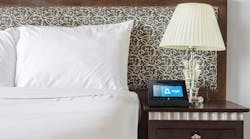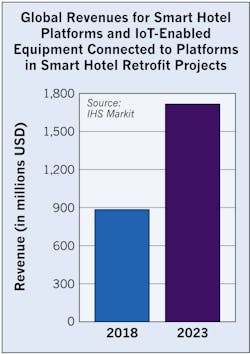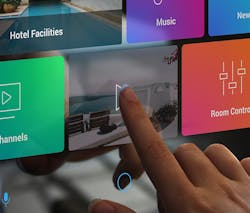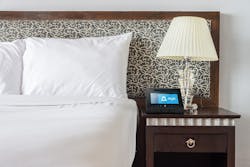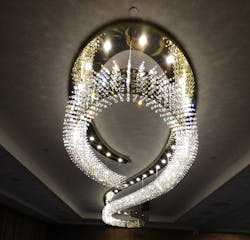Robotic butlers are zooming around hotel lobbies, bathroom mirrors are transforming into interactive touchscreens, and guests are opening their doors and controlling the lights/temperature in their rooms — all from their smartphones.
These amenities may seem years — or even decades — away, but in reality they are available today. Major hotel chains have discovered how to integrate IoT technology and smart building products into hotel rooms. Thus, the companies can increase the comfort, security, and convenience for their guests, all while conserving energy. In fact, hospitality represents the second fastest growing end-user industry for sales of IoT-enabled equipment worldwide and trails only the health care sector, per IHS Markit, a research firm. The company projected that the global market size for IoT-enabled equipment installed in smart hotel projects is expected to more than double in size between 2018 and 2024 (see the Figure).
“In general, hotels are industry leaders in adopting higher-tier domain integrations, with climate control, lighting, access control, intruder alarm, and even elevators connected through single platforms,” says Bryan Montany, an analyst for the smart building category for IHS Markit. “These integrations are often limited to luxury buildings in other building types but are more common in mid-tier or three-star hotels, particularly among the major global hotel chains.”
For example, hotels are investing in smart room keys with mobile credentials for entrance into guest rooms and mobile applications, which allow guests to customize desired room settings such as temperature, lighting, and room service guidelines through their smartphones. In addition, hotels are integrating asset tracking solutions, smart speakers, smart mirrors, interactive walls, and robotic butlers into their properties.
“Hotels have become more high-tech and automated in many ways — much to the delight of many hotel guests,” says Tony Melanson of Aethon, which manufactures an autonomous mobile robot platform. “The technology will be there when it is needed or preferred, but will take a back seat when it’s time for personal interaction or services only a person can deliver.”
Expanding Market
In 2018, the United States alone captured more than 25% of the total global market size for IoT-enabled equipment in smart hotels. Worldwide, not only North America, but also Western Europe, China, Japan, and the Middle East carry the strongest growth projections at more than 15% growth annually, per IHS Markit.
Around the world, hotels are investing in retrofit projects, which is driving the sales of IoT-enabled equipment. Most other commercial building types are renovated about every 25 to 30 years, but hotels are retrofitted with updated equipment in less than 10-year intervals, Montany says. In addition, he says hotels offer a more tangible return on investment (ROI) than other building types.
“Many other building owners are dissuaded by the initial cost of investing in new technologies, especially for retrofit projects where existing technology in buildings is still functional,” Montany says. “Building owners have frequently indicated a general desire to invest in more IoT-enabled equipment, but vendors can often only offer assurances that adopting their technologies will result in energy savings or increased occupant comfort.”
In other end-user sectors, such as retail stores/offices, it’s challenging to estimate how IoT technology can translate into improved productivity or a better shopping experience, Montany says. Hotels, however, are a different ballgame.
“In hospitality, the comfort and customization of spaces within guest rooms are precisely what guests are interested in,” Montany says. “Smart hotels differentiate themselves from the competition by connecting guests to a comfortable, intuitive, and individualized experience in their rooms.”
In turn, smart hotels can encourage guest loyalty, leading to a direct correlation between the adoption of IoT-enabled smart building technologies and increased revenues for the hotel.
“This is leading more stakeholders in the hospitality industry to view IoT-enabled devices as necessities rather than just ‘nice-to-have’ optional quality-of-life enhancements,” Montany says. “The combination of rapid growth in an emerging market and the unique challenges hotels face in optimizing individual guest rooms leads to a much more competitive market for smart buildings platform providers and IoT equipment manufacturers.”
From Smart Home to Smart Hotel
Electrical contractors, who are often familiar with the smart home market, may see more home product manufacturers move into the hospitality space than any other non-residential end-user industry. The reasons for this are simple: Guest rooms are similar in form and function to residential bedrooms, and guests’ familiarity with smart home products makes it easier for them to use the technology while staying at a hotel.
“Technologies and IoT brands adopted in the smart home are frequently also present in smart hotels,” Montany says. “For example, hotels are projected to be one of the strongest non-residential markets for smart speakers, with accelerating growth projected for voice command technologies between 2017 and 2025.”
At the same time, however, Montany says privacy concerns may limit the scope of voice command technology in this sector. For this reason, developers and providers of voice control technology will need to bear in mind the differences between home use and the inherent public aspect of the hotel environment.
“The trend toward personalization means that devices for home use are meant to have a relationship with just one person or family — not many, as is required in the hotel environment,” said Ted Helvey, CEO of Angie Hospitality, developer of Angie, the first 24-hour interactive guest room assistant to be purpose-built for the hotel environment. “The ideal solution needs to be designed for a multi-user environment, which means that it needs to adapt to various types of guests with different needs, languages, accents, etc. Due to security concerns about voice technology, it also needs to leverage additional security protocols to protect sensitive personal information. In designing Angie, we made sure that all guest data can be manually deleted or automatically erased upon check-out. If the guest prefers, they can also turn off the voice-command feature, and use the touch screen instead.”
Another common technology used in a smart hotel room that involves guest security is a smart room key. This technology represents a new way for guests to enter their rooms, with mobile devices acting as a digital keycard that downloads access control credentials to gain secure access to their assigned room or other secured areas. When a guest reserves a room, encrypted codes would be sent to his or her phone along with the corresponding room number. When the date of the reservation is reached, the hotel room door can automatically unlock when a smartphone with the code is held near it.
“This represents a convenient technology for guests and saves money for hotel owners, as physical credentials in hospitality are often misplaced and stolen,” Montany says.
IHS Markit estimated that 2% to 4% of all hotels worldwide are using mobile credentials to control access to their guest rooms, but that percentage could jump to 10% in just four years. At just one hotel chain, Hilton, the use of this technology has grown exponentially. Hilton Honors members did 34 million digital check-ins, four million room key downloads, and opened more than 18.7 million doors using the company’s “Digital Key” technology. Today, 65% of Hilton hotels now offer this amenity.
In addition, smart hotels can invest in interactive walls, which can be customized by guests to display colors and artwork in guest rooms to match their unique tastes and preferences, allowing for more personalization of their spaces. For example, within Hilton’s Connected Rooms, guests can personalize and control the temperature, lighting, TV, and window coverings. In the long term, that means guests may be able to upload their photos and art to display digitally in the room or even use voice commands to control their room’s features or to access their own content. Through the Hilton Honors app, they will be able to save these settings for future hotel stays.
Josh Weiss, vice president of Digital Product Innovation at Hilton, says with the growth of global travel, travelers are increasingly expecting an experience as good as, and ideally, better than what they are accustomed to at home.
“Hospitality companies have an exciting challenge to find new ways to offer guests the control, connectivity, and personalization they increasingly want when they’re on the road,” Weiss says. “Hilton has answered the call with our Connected Room platform, which is rooted in the unique needs of each guest.”
To decide which smart technologies to integrate within their hotels, major hotel chains have implemented research labs, often in partnerships with designated IoT equipment or platform vendors, to test the products, Montany says. For example, Marriott partnered with Legrand and Samsung about a year ago to launch its smart room concept — the IoT hotel room — after researching technology within its Innovation Lab at its corporate headquarters.
Within the next five years, consumers will start to see elements of the technologies within guest rooms, per Marriott. Through voice control or an app, guests will soon be able to ask a virtual assistant for a wake-up alarm, start up a yoga routine on a full-length mirror, start the shower, or ask for housekeeping services.
“We’re proud to be innovating with industry-leading partners to get closer to revolutionizing the guest experience, along with hotel operations and even hotel construction,” said Karim Khalifa, senior vice president, Global Design, Marriott International. “Together with Samsung and Legrand, we are well on our way to creating the hotel room of the future.”
Serving Hotel Guests
Advanced luxury hotels are also installing smart mirrors, which can display information related to local weather, sports scores, news articles, flight information, and other pertinent data related to a guest’s stay. To receive immediate real-time updates, guests do not need to log into any of their devices. In addition, they can modify parameters associated with the data to be displayed. For example, Electric Mirror, an Everett, Wash.-based company, offers a variety of products including lighted bathroom mirrors, makeup mirrors, and wardrobe mirrors. The company, which has served different industries for more than two decades, also produces entertainment mirror TVs and bathroom mirror TVs. Recently, about 150 of the company’s Savvy SmartMirrors were installed in the guest bathrooms in the new, upscale Sinclair Hotel in Fort Worth, Texas. The hotel, which is part of Marriott’s luxury hospitality brand, installed the mirrors to perform like an in-room concierge.
Guests can make dinner reservations, request extra pillows or a late check-out, or retrieve their car through the settings on the touch-screen mirror. They can also obtain information on hotel services and local events and attractions as well as set a lighting scene, lock a door, open the curtains, or play music. In addition, they can stream real-time news, weather and sports and broadcast TV shows or music all on the smart mirror, which is based on a cloud-based platform, allowing for software updates and upgrades. Since Savvy is built into the mirror, the hotels don’t need to invest in any other in-room devices or set up special apps.
“Savvy is the first smart mirror designed specifically for hotels,” said Jim Mischel, CEO of Electric Mirror. “Offering personalized communication, information, and entertainment, Savvy creates a level of luxury and pampering for guests that’s never before been seen.”
Meanwhile, robotic butlers are greeting guests at the front desk and deliver towels and toiletries to rooms in hotels worldwide. For example, Aethon programs robots that can handle the routine delivery tasks within a hotel operation. The robots are autonomous and self-driving based on specified routes, can travel to specified destinations, and can even ride elevators. These routes often include areas such as the lobby, guest room floors, common spaces, banquet rooms, convention service areas, and the basement.
“The robot only can go where it has programmed access,” Melanson says. “For example, we can deliver meals or specific guest-requested items to a guest room location. While we don’t go into the room, the robot rings the phone of the guest room or sends a text when their delivery arrives.”
Melanson says guests appreciate the convenience, privacy, and security of the room service delivery. At the same time, however, the robots can also haul up to 1,400 pounds, if needed, allowing them to help departments like housekeeping and convention services.
When Aethon deploys a robot to a hotel, the company connects the robot to its command center via the Internet using the hotel’s Wi-Fi. Aethon can monitor the robots 24/7 and detect any issues for the customer before they turn into problem. Since most of the navigation is done onboard the robot, Aethon doesn’t require new infrastructure to get its robots up and running. The company has an in-house team of installers and third parties to help install and program the robots to meet the hotels’ needs. In addition, Aethon can dispatch local service technicians to replace parts when needed.
“Robots are more like a computer system,” Melanson says. “They need to be configured and programmed to meet the specific needs of the hotel and the facility layout.”
Melanson says the nature of guest services is changing, and the smart hotel trend made it attractive to enter this market after serving the health care industry.
“We felt that we could bring something really unique to the hospitality space by offering an autonomous mobile robot platform that would deliver value and efficiency for the back-of-house as well as a new guest experience for the front-of-house,” Melanson says.
Working Alongside Integrators
As the number of “smart hotels” continues to grow, electrical contractors must become adequately trained to handle this transition and will work alongside solutions providers and system integrators.
“The role of electrical contractors is evolving as smart hotel concepts grow in the market,” Montany says.
On smart hotel projects, the technology and construction worlds collide. IoT-enabled systems are increasingly involving a combination of products from the security, energy and IT domains. As such, end-users are selecting solutions providers that can offer broader and more comprehensive support for mechanical, electrical, and IT systems within their buildings.
“There’s a real chance that third-party electrical contractors may be shut out of more hotel projects as vendors will increasingly push for comprehensive solution providers and experienced systems integrators to take over this role,” Montany says. “The role of the third-party electrical contractor won’t disappear overnight, but we’re seeing an increasing percentage of major manufacturers disrupt the space through their own internal solutions departments.”
After becoming trained on the technology, some electricians may opt to get new jobs with these corporations or find ways to work alongside other team members. Montany says on smart hotel projects, the role of the electrical contractor is becoming less and less siloed.
“Electrical contractors are no longer separate from or distinguished from mechanical installers, IT professionals, architects, system engineers and other project stakeholders,” Montany says. “Electrical contractors are going to need to re-educate themselves, and contractors with broader experience will have more opportunities for future projects.”
Melanson agrees. “So much is happening with connected devices, wireless data, and smart systems that if electrical contractors have a portion of their business that understands and can deliver these solutions, it would seem to be lucrative,” he says.
Case in point: Hays Electrical Services in Humble, Texas, has worked on a variety of different hospitality projects. For example, the company renovated the Baltimore Marriott Waterfront, is currently working on the Westin Oaks, and is about ready to start the Baltimore Renaissance Hotel. Each of these projects has different requirements, but oftentimes, the electricians change out devices to become code-compliant, install light dimming systems, and perform full LED upgrades, says James Decker, project manager and estimator.
“We roll with it, one hotel at a time,” Decker says.
To keep up to speed on the rapid advances in technology, the electrical contractor invites specialized vendors to provide training. On many of the projects, however, the electricians handle the installation, and then the vendor is responsible for the programming. For example, on a recent project, the electricians installed a dimming system, and then a lighting designer set the scenes and zones to meet the hotel’s desires and specifications.
At a Westin property, the electricians installed LED lamps within the ballroom chandeliers and the luminaires in the meeting spaces and the lobby. By using an app on their smartphone or tablet, the hotel staff can control the energy-efficient, long-lasting lights. In addition, in the Presidential Suite at this hotel, the electricians installed a Bluetooth speaker in the mirror so guests can listen to the radio while they’re in the shower.
“It’s very similar to installing a lighted mirror with wall sconces,” he says. “You take the power and run it to the center of the mirror, and then you hook up the chassis to the mirror.”
When it comes to smart hotels, Montany says there isn’t a significant differentiation in the technologies employed in new construction versus retrofit projects. Instead, the difference between new construction and retrofit often lies in the architectural design of the guest rooms. For example, the hotels can opt for wireless or wired devices or feed data through existing platforms or install new ones.
“Wireless equipment is more common in retrofit projects as the equipment can be installed anywhere and connect to existing building management system platforms,” Montany says. “In new construction projects, it can be more cost-effective to simply install wiring for all the products.”
Conserving Energy
Oftentimes, the hotels are installing smart technology to save energy, and therefore increase profits, Decker says. For example, along with swapping out incandescent lamps with LEDs in everything from the bathrooms to the guest rooms to the common areas, hotels are also investing in occupancy sensors, especially in those areas that must abide by Title 24 regulations.
“It’s not as big in Houston, but on the East and the West Coast, they are super big on energy management,” Decker says. “If the room is not occupied, the power in the room gets shut down, and it’s activated by your own room card key. When you walk into your room, it activates your lights and 50% of the receptacles. It conserves a lot of energy in the hotel.”
In a traditional hotel room, everything is on a riser, and wiring goes up and down the walls, Decker says. In a smart room, however, the wiring needs to be directed toward the entry of the guest room. And during a renovation project, it requires major modifications to put in a master control switch.
“A lot of times, they will put in sensors and switches to substitute for that, which is a lot easier and cheaper,” Decker says. “It depends how in-depth a hotel wants to get with it.”
Regarding energy management, many hotel guests expect lighting and HVAC systems to automatically turn on or off, depending upon their occupancy in the room.
“That’s a very simple level of automation that hotels can achieve without much integration of IoT technologies,” Montany says. “Many hotels are trying to jump ahead of the curve of guest expectations and differentiate themselves by offering more customization of energy and lighting systems in guest rooms than what’s generally demanded today.”
For example, luxury hotels and some hotel chains are pushing lighting and climate control over guest rooms further through occupancy sensors, building management system platforms, and applications on users’ mobile devices, Montany says. Through mobile applications, guests can directly alter various room settings to match their personal preferences by establishing a personal profile. These preferences are then stored and associated with that guest, so any guest room that becomes associated with that guest’s account can automatically be adjusted to the guest’s preferred parameters including lighting and climate settings.
“When the front desk assigns a guest room, equipment in that room will automatically adjust, allowing the room to be heated or cooled to the guest’s preferred temperature before the guest even arrives in the room,” Montany says.
Due to the smart hotel trend, hotels are now installing two separate and distinct smart building systems that operate semi-independently of one another to monitor guest rooms and common areas of the building. This allows hotels to limit energy consumption in common spaces while retaining a unique, customizable framework for individual guest rooms. That way, guests can override standard settings through manual inputs.
To achieve smart guest rooms, hotels must install a multitude of occupancy sensors. Due to privacy concerns, hotels are often not including enhanced features such as video technology within these occupancy sensors. Hotels, however, are installing IoT-enabled connected lighting systems and building automation equipment, which are integrated together through an analytics platform.
Looking forward, Melanson says hotel guests will have higher demands when it comes to not only the availability of technology, but also the integration.
“It won’t be enough for it to be simply present,” Melanson says. “Guests will judge you on the quality of the experience and the fusion between the digital and the analog. Like the smart home, it must elegantly fit in and be ready when you are. Smart hotels will automate as well as delight.”
Editor’s Note: To see the Hilton’s Connected Room in action, visit https://youtu.be/9FzeN6z0cos.
Fischbach is a freelance writer and editor based in Overland Park, Kan. She can be reached at [email protected].
Sidebar: Three Key Economic Trends in the Hotel Construction Market
The hotel construction market is staying at a relatively healthy level of activity compared to the last 20 years, according to Dodge Data & Analytics. Robert Murray, chief economist and vice president of Dodge Data & Analytics, shares an update on the hotel market, which is facing some challenges moving forward.
1. Slight slowdown for hotel construction starts. Hotel construction starts in 2018 are estimated to rise 4% to 77 million sq ft and 10% to $18.5 billion, which follows a slight pullback in 2017, when activity slipped 2% to 74 million sq ft and 3% to $16.9 billion, following the double-digit percentage growth that was reported each year from 2011 through 2016. For next year, Murray forecasts that hotel construction starts will retreat 8% to 71 million sq ft and 6% to $17.4 billion.
2. Shift toward more traditional hotel developments over casinos or convention centers. At this point, 37 of the 50 states have already legalized gambling, and, as such, casino development may no longer offer the vigorous boost to hotel construction that’s been present for the past several years, Murray says. Despite the growth in hotel construction starts estimated for 2018, Murray says he has already seen fewer projects connected with casino and convention center development. For example, in 2017, 21 hotels with a dollar value of least $100 million broke ground. Of those, eight were associated with casinos and two with convention centers. In the first 10 months of 2018, 20 hotels broke ground with a dollar value of $100 million or more, but only one was associated with a casino, and only one was associated with a convention center. The largest projects breaking ground in 2018 were more traditional hotels, he says.
3. Slowing rate of improvement for hotel occupancy rates and revenue per available room. Hotel market fundamentals may have picked up in 2018, benefiting from a strong U.S. economy, but the deceleration in market fundamentals is expected to resume in 2019 as the U.S. economic expansion settles back to a more moderate pace, Murray says.
